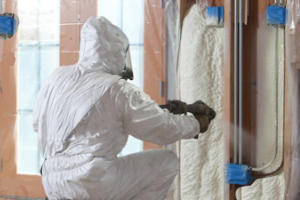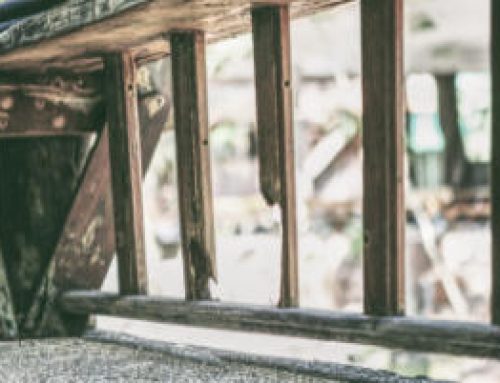While Spray Polyurethane Foam  (SPF) insulation has gained popularity as a highly effective method for improving energy efficiency, air sealing, and thermal performance in residential homes and commercial buildings, it comes with a set of potential dangers and risks that warrant careful consideration. From chemical exposure during application to fire hazards, bad mixes during application, and indoor air quality concerns, understanding the potential dangers of Spray Polyurethane Foam (SPF) insulation is essential.
(SPF) insulation has gained popularity as a highly effective method for improving energy efficiency, air sealing, and thermal performance in residential homes and commercial buildings, it comes with a set of potential dangers and risks that warrant careful consideration. From chemical exposure during application to fire hazards, bad mixes during application, and indoor air quality concerns, understanding the potential dangers of Spray Polyurethane Foam (SPF) insulation is essential.
Chemical Exposure
One of the primary concerns with spray foam insulation is the presence of isocyanates, chemicals known to cause respiratory and skin irritation. During application, spray foam insulation releases gas vapors containing isocyanates. Prolonged or repeated exposure without adequate ventilation or protective equipment can lead to more severe health effects, including asthma, bronchitis, and other respiratory disorders for the applicators.
Overfilling
When Spray Polyurethane Foam (SPF) is being applied, it can expand rapidly to fill gaps and cavities. If not applied correctly, this expansion can lead to overfilling or uneven distribution, resulting in problems or reduced effectiveness. Additionally, improper installation can create air pockets or voids which can compromise the insulation’s performance and allow for moisture infiltration, leading to potential microbial growth and other issues.
Flammability
Spray Polyurethane Foam (SPF) insulation can be highly flammable during installation. Exposed Spray Polyurethane Foam is combustible, and if exposed to ignition sources such as open flames or sparks, can ignite rapidly, posing a fire hazard. In the event of a fire, the insulation can release toxic gases and smoke, such as hydrogen cyanide, and other toxic gases which can impair respiratory function and exacerbate potential fire-related injuries.
Air Quality Issues
While properly cured Spray Polyurethane Foam (SPF) is generally considered inert, off-gassing of Volatile Organic Compounds (VOCs) can occur during and after installation, potentially leading to indoor air quality issues for the residents. The VOCs can evaporate into the air and may cause short-term and long-term health effects, including headaches, dizziness, nausea, and irritation of the eyes, nose and throat. Pets may also be susceptible, and pet owners should take precautions during and after installation until the product has fully cured. Adequate ventilation is crucial during and after application of SPF.
Related: 5 Spray Foam Insulation Problems
What is Spray Polyurethane Foam (SPF) Insulation?
Spray Polyurethane Foam (SPF) is commonly used in new and existing construction to enhance energy efficiency. It is typically applied as a two-part liquid that mixes at the tip of the applicator nozzle and expands into a cured foam when sprayed onto surfaces to fill gaps, crevices, and irregularly-shaped spaces, creating a seamless insulation layer that provides air sealing, thermal resistance, and helps to regulate indoor air temperatures.
The insulation method involves the use of chemicals, typically polyurethane or polyisocyanurate, which react and expand rapidly when mixed together. The foam adheres tightly to surfaces to form an airtight barrier. Spray Polyurethane Foam is commonly used in walls, ceilings, attics, and crawl spaces for encapsulation.
There are two main types of Spray Polyurethane Foam insulation:
- Open-cell foam is lighter and less dense, with a spongy texture that allows for more flexibility and moisture vapor permeability.
- Closed-cell foam is denser and more rigid, providing higher insulation values and greater resistance to moisture penetration.
Alternatives to Spray Foam Insulation
Mineral Wool Insulation
Also known as rock wool or slag wool, mineral wool insulation is made from natural minerals such as basalt or slag and is available in batts, boards, or loose-fill forms. It is non-combustible, moisture resistant, and provides excellent thermal and acoustic insulation properties.
Fiberglass Insulation
Widely used in home construction due to its affordability, ease of installation, and effectiveness in reducing heat transfer and air leakage, traditional fiberglass insulation is an alternative to those concerned with the dangers of SPF insulation. Fiberglass insulation is made from fine glass fibers and is available in batts, rolls, or loose-fill forms.
Cellulose Insulation
Cellulose insulation is an eco-friendly option made from recycled paper products treated with fire retardants. It is blown or sprayed into wall cavities, attics, and other spaces, where it forms a dense layer that provides thermal resistance and helps seal gaps and cracks.
Reflective Insulation
Reflective insulation, such as radiant barrier foil or reflective bubble wrap, can be used in conjunction with traditional insulation materials. It works by reflecting radiant heat away from the home, helping to reduce heat gain in summer and heat loss in winter.
How Först Can Protect You from potential Spray Polyurethane Foam (SPF) Dangers
Först Consulting Group can employ several methods to check a building for faulty application of Spray Foam Insulation.
- Visual inspection. We will visually examine the insulation material for signs of overfilling, uneven distribution, or gaps and voids in areas where spray foam insulation is commonly used.
- Thermal imaging technology. Thermal imaging cameras can identify temperature variations and potential insulation defects that may indicate faulty installation or insulation deficiencies.
- Air leakage testing. A blower door test pressurizes or depressurizes a building to simulate typical airflow conditions, allowing us to measure the air infiltration rate and identify leakage areas. By combining blower door testing with smoke pencils or fog machines, we can identify air leakage pathways to assess the SPF effectiveness in sealing gaps and cracks.
- Lab samples. Our technicians may take samples of your SPF insulation for laboratory analysis to test for the presence of harmful chemicals, as well as evaluate the insulation’s thermal resistance and adherence to industry standards and regulations.
- Documentation. Först Consulting Group can review documentation related to the spray foam installation, including contractor invoices, permits, and building codes compliances. This can ensure that all applicable regulations and safety standards have been followed. A complete written report will be issued as documentation.
Contact Först Consulting Group
If you suspect issues with your Spray Polyurethane Foam (SPF) insulation or its installation deficiencies, contact Först Consulting Group. We serve residential, commercial, and community association clients throughout the Northern Virginia and Washington, D.C. metropolitan region.


